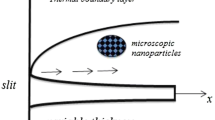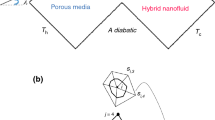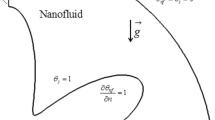Abstract
The mathematical model for nanomaterial convection through a complex geometry in presence of Kelvin force has been reported in this article. To involve the feature of nanomaterial, single phase model was selected which has nice accuracy for low concentration of iron oxide. Impose of magnetic source next to inner hot wall generates the new force which helps the nanofluid migration. The mathematical equations were solved via CVFEM. The accuracy of method was checked with comparing results against old publication. The styles of flow and isotherms with change of Ra, MnF were examined in results. Augment of Kelvin force converts the sole vortex to two eddies with opposite directions in low Ra and thermal plume appears inside the domain. Rise of buoyancy makes the strength of eddy to augment and Kelvin force makes the streamline values to increase. Nu enhances about 179. 36% with rise of Kelvin forces when Ra = 1e5. Nu augments about 11.13% with dispersing nanoparticles in to H2O. Rise of Ra makes Nu to grow about 119.97% when MnF = 4000.






Similar content being viewed by others
References
Abdulkadhim A, Hamzah HK, Ali FH, Abed AM, Abed IM (2019) Natural convection among inner corrugated cylinders inside wavy enclosure filled with nanofluid superposed in porous–nanofluid layers. Int Commun Heat Mass Transfer 109:104350
Benos LT, Karvelas EG, Sarris IE (2019) Crucial effect of aggregations in CNT-water nanofluid magnetohydrodynamic natural convection. Thermal Sci Eng Progress 11:263–271
Duan Y, Liu Y, Chen Z, Liu D, Yu E, Zhang X et al (2020) Amorphous molybdenum sulfide nanocatalysts simultaneously realizing efficient upgrading of residue and synergistic synthesis of 2D MoS2 nanosheets/carbon hierarchical structures. Green Chem 22(1):44–53. https://doi.org/10.1039/C9GC02855B
Groşan T, Revnic C, Pop I, Ingham DB (2015) Free convection heat transfer in a square cavity filled with a porous medium saturated by a nanofluid. Int J Heat Mass Transfer 87:36–41
Huang W, Wang G, Li W, Li T, Ji G, Ren S et al (2020) Porous ligand creates new reaction route: bifunctional single-atom palladium catalyst for selective distannylation of terminal alkynes. Chem 6(9):2300–2313. https://doi.org/10.1016/j.chempr.2020.06.020
Hussain S, Ahmed SE (2019) Steady natural convection in open cavities filled with a porous medium utilizing Buongiorno’s nanofluid model. Int J Mech Sci 157–158:692–702
Khanafer K, Vafai K, Lightstone M (2003) Buoyancy-driven heat transfer enhancement in a two-dimensional enclosure utilizing nanofluids. Int J Heat Mass Transfer 46:3639–3653
Li H, Xu B, Lu G, Du C, Huang N (2021a) Multi-objective optimization of PEM fuel cell by coupled significant variables recognition, surrogate models and a multi-objective genetic algorithm. Energy Conversion Manag 236:114063. https://doi.org/10.1016/j.enconman.2021.114063
Li H, Gao Y, Du C, Hong W (2021b) Numerical study on swirl cooling flow, heat transfer and stress characteristics based on fluid-structure coupling method under different swirl chamber heights and Reynolds numbers. Int J Heat Mass Transfer 173:121228. https://doi.org/10.1016/j.ijheatmasstransfer.2021.121228
Li Z, Shi Y, Zhu A, Zhao Y, Wang H, Binks BP et al (2021c) Light-responsive, reversible emulsification and demulsification of oil-in-water pickering emulsions for catalysis. Angewandte Chemie (international Ed.) 60(8):3928–3933. https://doi.org/10.1002/anie.202010750
Liu Y, Xu T, Liu Y, Gao Y, Di C (2020) Wear and heat shock resistance of Ni-WC coating on mould copper plate fabricated by laser. J Mater Res Technol 9(4):8283–8288. https://doi.org/10.1016/j.jmrt.2020.05.083
Liu H, Li X, Liu X, Ma Z, Yin Z, Yang W et al (2021) Schiff-base-rich g-CxN4 supported PdAg nanowires as an efficient Mott-Schottky catalyst boosting photocatalytic dehydrogenation of formic acid. Rare Met 40(4):808–816. https://doi.org/10.1007/s12598-020-01637-5
Manh TD, Salehi F, Shafee A, Nam ND, Shakeriaski F, Babazadeh H, Vakkar A, Tlili I (2021) Role of magnetic force on the transportation of nano powders including radiation. J Thermal Anal Calorimetry. https://doi.org/10.1007/s10973-019-09182-9
Meng F, Pang A, Dong X, Han C, Sha X, Jing N et al (2018) H∞ optimal performance design of an unstable plant under bode integral constraint. Complexity (new York, NY). https://doi.org/10.1155/2018/4942906
Meng F, Wang D, Yang P, Xie G, Cutberto R et al (2019) Application of sum of squares method in nonlinear H∞ control for satellite attitude maneuvers. Complexity (new York, NY). https://doi.org/10.1155/2019/5124108
Ni Z, Cao X, Wang X, Zhou S, Zhang C, Xu B, Ni Y (2021) Facile synthesis of copper(I) oxide nanochains and the photo-thermal conversion performance of its nanofluids. Coatings 11:749. https://doi.org/10.3390/coatings11070749
Nithyadevi N, Begum AS, Oztop HF, Abu-Hamdeh N (2017) Mixed convection analysis in heat transfer enhancement of a nanofluid filled porous enclosure with various wall speed ratios. Int J Heat Mass Transfer 113:716–729
Oğlakkaya FS, Bozkaya C (2016) MHD natural convection in a semi-annulus enclosure filled with water-based nanofluid using DRBEM. Eng Anal Boundary Elements 71:151–163
Qi C, Tang J, Ding Z, Yan Y, Guo L, Ma Y (2019) Effects of rotation angle and metal foam on natural convection of nanofluids in a cavity under an adjustable magnetic field. Int Commun Heat Mass Transfer 109:104349
Qin Y (2021a) Simulation of MHD impact on nanomaterial irreversibility and convective transportation through a chamber. Appl Nanosci. https://doi.org/10.1007/s13204-021-01941-1
Qin Y (2021b) Effect of inclusion of nanoparticles on unsteady heat transfer. Appl Nanosci. https://doi.org/10.1007/s13204-021-01960-y
Qin Y (2021c) Nanofluid heat transfer within a pipe equipped with external device. Int Commun Heat Mass Transfer 127:105487
Raju CSK, Hoque MM, Anika NN, Mamatha SU, Sharma P (2017) Natural convective heat transfer analysis of MHD unsteady Carreau nanofluid over a cone packed with alloy nanoparticles. Powder Technol 317:408–416
Ren S, Ye B, Li S, Pang L, Pan Y et al (2021) Well-defined coordination environment breaks the bottleneck of organic synthesis: single-atom palladium catalyzed hydrosilylation of internal alkynes. Nano Res. https://doi.org/10.1007/s12274-021-3694-3
Said Z, Sundar LS, Tiwari AK, Ali HM, Sheikholeslami M, Bellos E, Babar H (2021) Recent advances on the fundamental physical phenomena behind stability, dynamic motion, thermophysical properties, heat transport, applications, and challenges of nanofluids. Phys Rep. https://doi.org/10.1016/j.physrep.2021.07.002
Sheikholeslami M (2019) New computational approach for exergy and entropy analysis of nanofluid under the impact of Lorentz force through a porous media. Comput Methods Appl Mech Eng 344:319–333
Sheikholeslami M, Farshad SA (2021) Investigation of solar collector system with turbulator considering hybrid nanoparticles. Renew Energy 171:1128–1158. https://doi.org/10.1016/j.renene.2021.02.137
Sheikholeslami M, Ghasemi A (2018) Solidification heat transfer of nanofluid in existence of thermal radiation by means of FEM. Int J Heat Mass Transfer 123:418–431
Sheikholeslami M, Vajravelu K (2017) Nanofluid flow and heat transfer in a cavity with variable magnetic field. Appl Math Comput 298:272–282
Sheikholeslami M, Ghasemi A, Li Z, Shafee A, Saleem S (2018) Influence of CuO nanoparticles on heat transfer behavior of PCM in solidification process considering radiative source term. Int J Heat Mass Transfer 126:1252–1264
Sheikholeslami M, Rezaeianjouybari B, Darzi M, Shafee A, Li Z, Nguyen TK (2019) Application of nano-refrigerant for boiling heat transfer enhancement employing an experimental study. Int J Heat Mass Transfer 141:974–980
Sheikholeslami M, Farshad SA, Said Z (2021a) Analyzing entropy and thermal behavior of nanomaterial through solar collector involving new tapes. Int Commun Heat Mass Transfer 123:105190. https://doi.org/10.1016/j.icheatmasstransfer.2021.105190
Sheikholeslami M, Farshad SA, Ebrahimpour Z, Said Z (2021b) Recent progress on flat plate solar collectors and photovoltaic systems in the presence of nanofluid: a review. J Cleaner Prod 293:126119. https://doi.org/10.1016/j.jclepro.2021.126119
Shen G, Ma L, Zhang S, Zhang S, An L (2019) Effect of ultrasonic waves on heat transfer in Al2O3 nanofluid under natural convection and pool boiling. Int J Heat Mass Transfer 138:516–523
Sun J, Aslani F, Wei J, Wang X (2021) Electromagnetic absorption of copper fiber oriented composite using 3D printing. Constr Build Mater. https://doi.org/10.1016/j.conbuildmat.2021.124026
Wang D, Cheng P, Quan X (2019) A solid-liquid local thermal non-equilibrium lattice Boltzmann model for heat transfer in nanofluids. Part II: Natural convection of nanofluids in a square enclosure. Int J Heat Mass Transfer 130:1358–1365
Wang R, Yuan Y, Zhang J, Zhong X, Liu J, Xie Y et al (2021) Embedding Fe2P nanocrystals in bayberry-like N, P-enriched carbon nanospheres as excellent oxygen reduction electrocatalyst for zinc-air battery. J Power Sources 501:230006. https://doi.org/10.1016/j.jpowsour.2021.230006
Xu X, Nieto-Vesperinas M (2019) Azimuthal imaginary poynting momentum density. Phys Rev Lett 123(23):233902. https://doi.org/10.1103/PhysRevLett.123.233902
Xu Q, Liu L, Feng J, Qiao L, Yu C, Shi W et al (2020) A comparative investigation on the effect of different nanofluids on the thermal performance of two-phase closed thermosyphon. Int J Heat Mass Transfer 149:119189. https://doi.org/10.1016/j.ijheatmasstransfer.2019.119189
Yang Y, Chen H, Zou X, Shi X, Liu W, Feng L et al (2020) Flexible carbon-fiber/semimetal bi nanosheet arrays as separable and recyclable plasmonic photocatalysts and photoelectrocatalysts. ACS Appl Mater Interfaces 12(22):24845–24854. https://doi.org/10.1021/acsami.0c05695
Zhang X, Wang Y, Wang C, Su C, Li Z et al (2019) Adaptive estimated inverse output-feedback quantized control for piezoelectric positioning stage. IEEE Trans Cybern 49(6):2106–2118. https://doi.org/10.1109/TCYB.2018.2826519
Zhang Y, Li HN, Li C, Huang C, Ali HM, Xu X, Mao C, Ding W, Cui X, Yang M, Yu T, Jamil M, Gupta MK, Jia D, Said Z (2021a) Nano-enhanced biolubricant in sustainable manufacturing: from processability to mechanisms. Friction. https://doi.org/10.1007/s40544-021-0536-y
Zhang L, Zhang M, You S, Ma D, Zhao J et al (2021b) Effect of Fe3+ on the sludge properties and microbial community structure in a lab-scale A2O process. Sci Total Environ 780:146505. https://doi.org/10.1016/j.scitotenv.2021.146505
Zhuo Z, Wan Y, Guan D, Ni S, Wang L, Zhang Z et al (2020) A loop-based and AGO-incorporated virtual screening model targeting AGO-mediated miRNA–mRNA interactions for drug discovery to rescue bone phenotype in genetically modified mice. Adv Sci 7(13):1903451. https://doi.org/10.1002/advs.201903451
Acknowledgements
Bandar Almohsen is supported by Researchers Supporting Project number (RSP-2021/158), King Saud University, Riyadh, Saudi Arabia
Author information
Authors and Affiliations
Corresponding author
Ethics declarations
Conflict of interest
Researchers declare that there is no conflict of interest.
Additional information
Publisher's Note
Springer Nature remains neutral with regard to jurisdictional claims in published maps and institutional affiliations.
Rights and permissions
About this article
Cite this article
Almohsen, B. Impact of Kelvin force on treatment of nanofluid with mathematical modeling. Appl Nanosci 13, 2767–2775 (2023). https://doi.org/10.1007/s13204-021-02045-6
Received:
Accepted:
Published:
Issue Date:
DOI: https://doi.org/10.1007/s13204-021-02045-6




